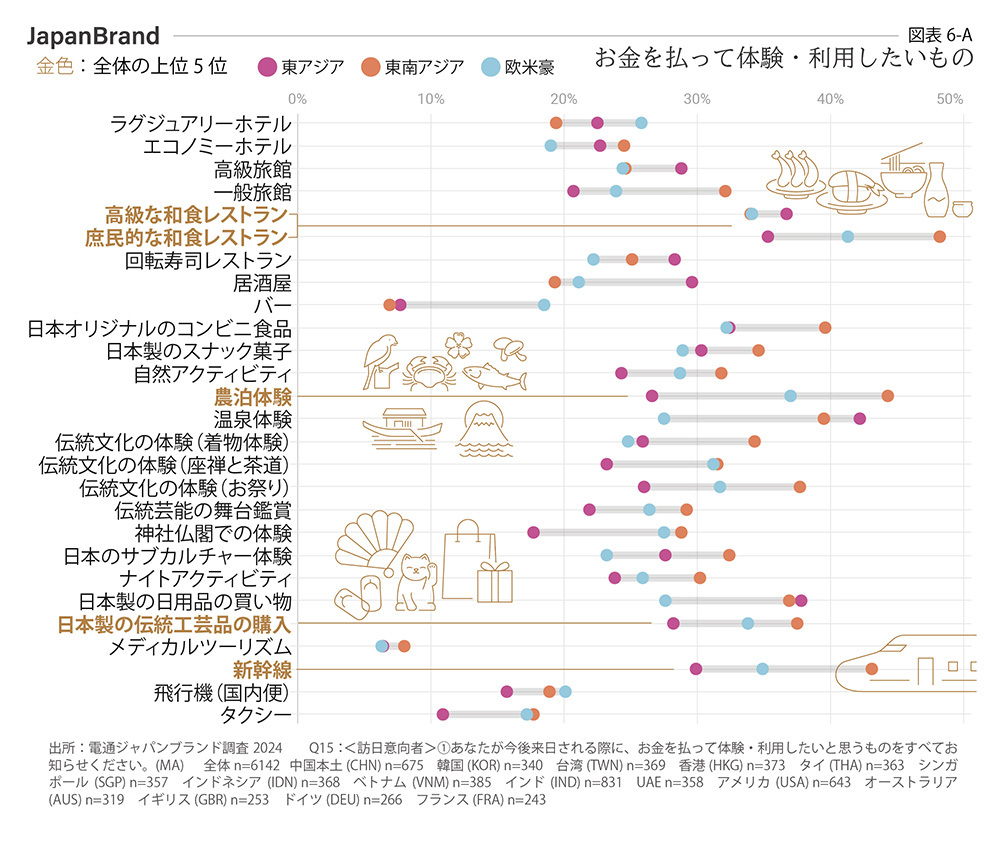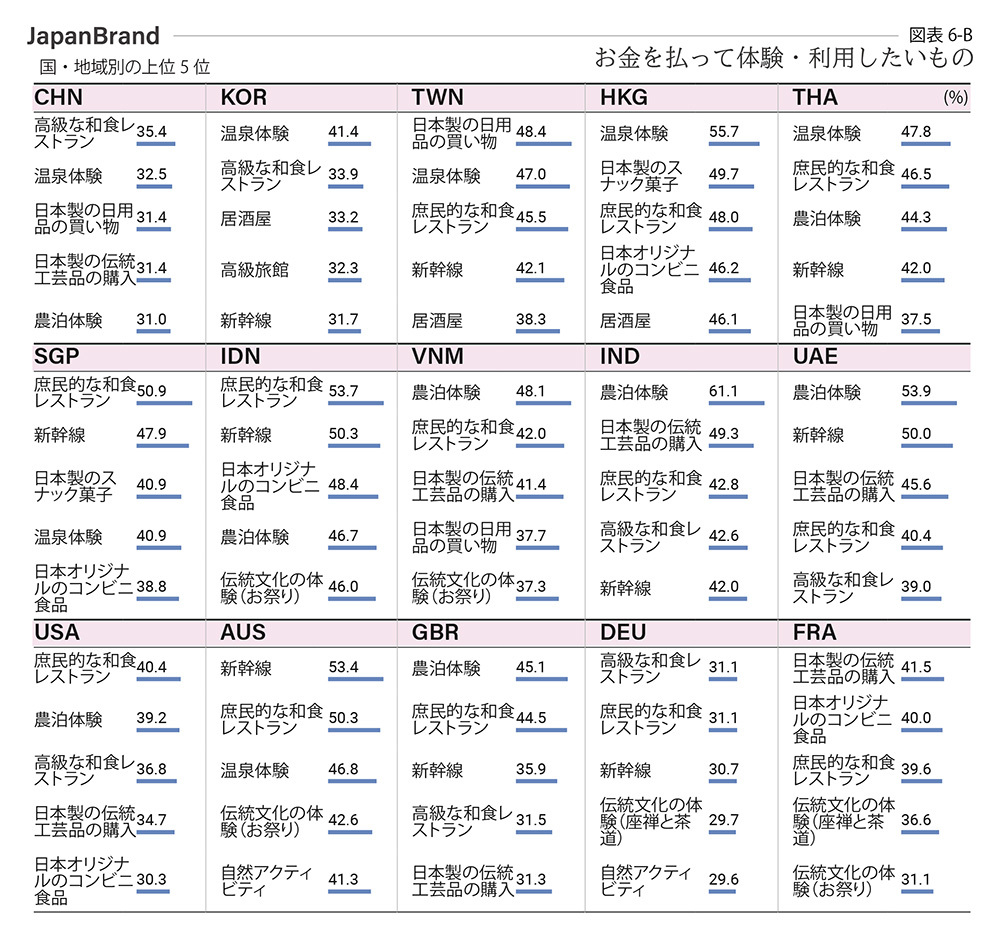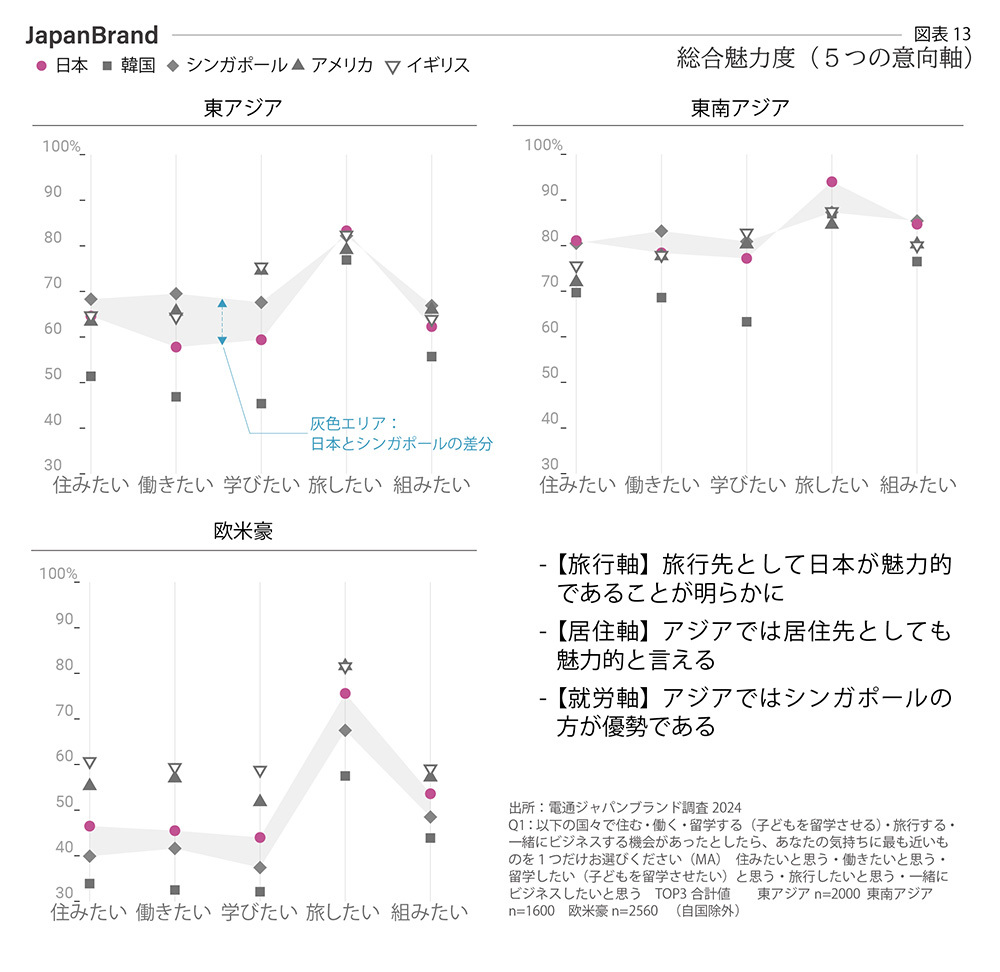Note: This website was automatically translated, so some terms or nuances may not be completely accurate.
[Report] Understanding the Current State of the "Japan Brand" Through 8 Key Points
Launched in 2011, the Japan Brand Survey is Dentsu's proprietary knowledge base initiative that regularly gauges the awareness and actual practices of overseas residents regarding the Japan Brand as a whole—covering areas like inbound tourism, food, Japanese products, content, and values.
Now in its 14th year, this survey continues to evolve its target regions and research items in step with the times. It not only contributes to increasingly data-driven, diverse, and complex corporate activities but also continues to disseminate insights for Japanese society.
In 2024, a large-scale survey was conducted across 15 countries and regions (United States, Australia, United Kingdom, Germany, France, India, United Arab Emirates, Indonesia, Singapore, Thailand, Vietnam, Mainland China, Hong Kong, Taiwan, South Korea) ( Survey Overview ).
As marketing professionals and as individuals in society, we sincerely hope to collectively build upon our modest contributions to cross-cultural understanding.
<Table of Contents>
▼Introduction
▼Point 01: Expectations
▼Point 02: Triggers
▼Point 03: Interests
▼Point 04: Regions
▼Point 05: Barriers
▼Point 06: Japanese Cuisine
▼Point 07: Appeal
▼Point 08: Employment
▼Conclusion
Introduction
Until now, Western nations have consistently dominated the top spots in various rankings measuring national strength and popularity. Amidst this, Japan stands as an unshakable presence, one of the few Asian countries to become a regular fixture in rankings of attractive nations. According to the latest statistics from the Japan National Tourism Organization (JNTO), the number of foreign visitors to Japan exceeded 3 million for four consecutive months from March to June 2024. Furthermore, it has surpassed the same months of 2019—which recorded the highest visitor numbers on record—for nine consecutive months (Note: November 2023 and January 2024 were nearly equal to the same months in 2019). [Figure 0]
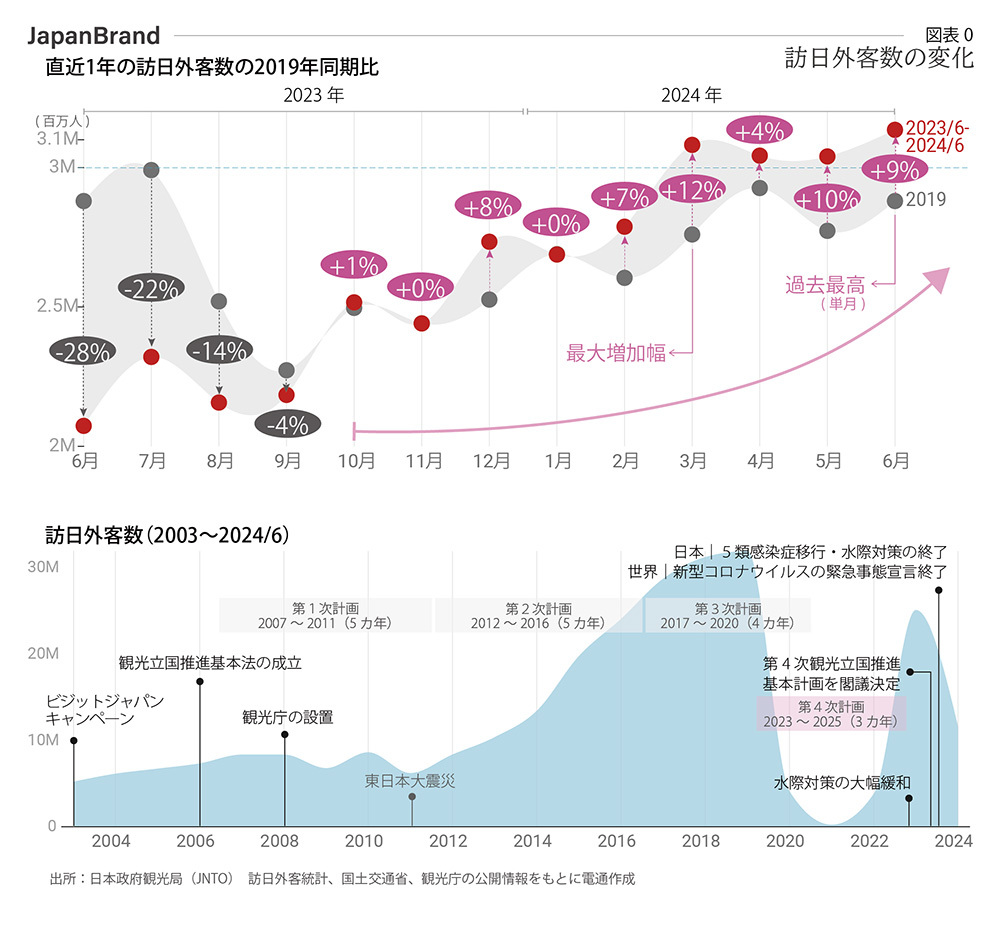
This series will analyze Japan's popularity from this macro perspective, based on the latest Japan Brand Survey and applying Dentsu's unique multifaceted approach. We will explore the challenges hidden beneath this popularity phenomenon and seek hints for expanding its potential.
The first installment introduces key findings from the latest survey across eight points. We hope this helps you grasp the current state of the Japan Brand: .
Point 01: Expectations
When we surveyed overseas travelers post-pandemic (within 2023) about their intent to revisit destinations, Japan ranked first. It also surpassed second-place Singapore and third-place America by nearly 20 percentage points. [Figure 1]
When viewed by region rather than country, Japan also leads in revisit intent across both East Asia and Southeast Asia. The gap was significant: 45.2 points ahead of second-place Hong Kong (13.1%) in East Asia and 23.8 points ahead of second-place Singapore (28.7%) in Southeast Asia.
Conversely, Japan's ranking dips slightly in Europe and North America, placing 10th in Europe (Spain ranked 1st) and 2nd in North America (United Kingdom ranked 1st). This clearly shows that Japan's popularity as a tourist destination is overwhelmingly supported by Asia. [Figure 2]

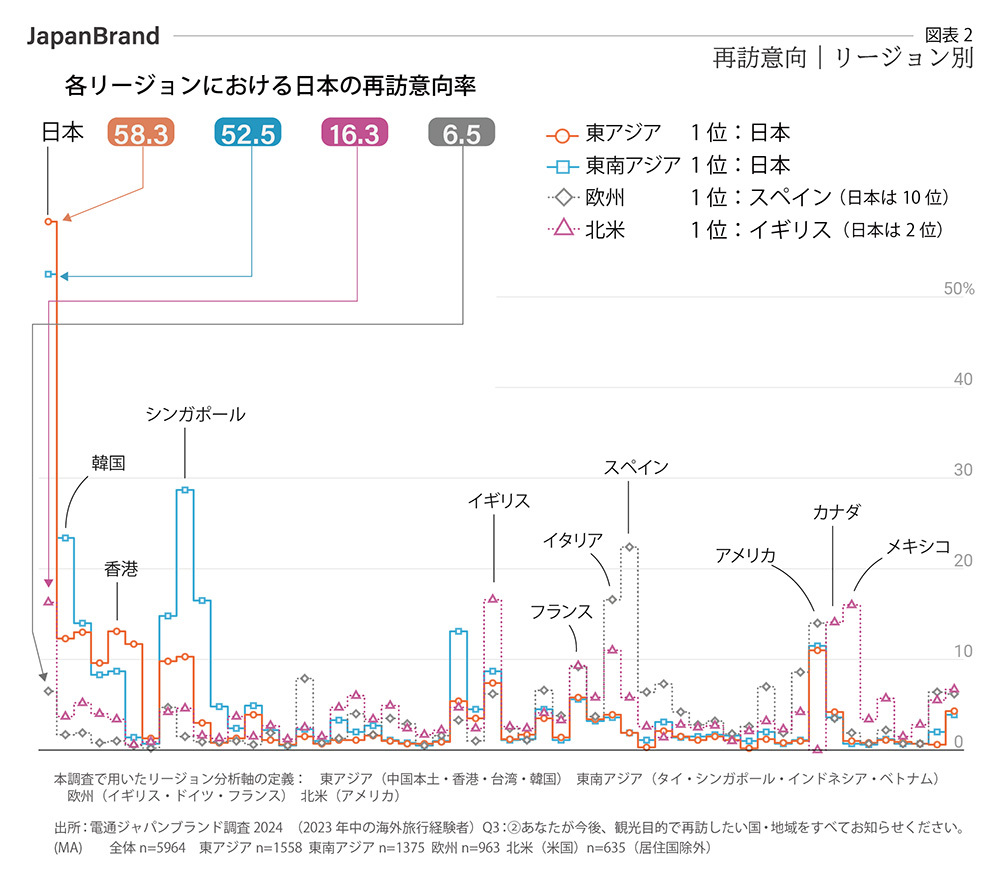
Regarding what overseas residents most expect from Japan, recognized as an attractive travel destination, the top five expectations were as follows:
① Diverse cuisine
② Unique culture distinct from other countries
③ Natural landscapes found nowhere else
④ Coexistence of modernity and tradition
⑤ A sense of cleanliness unmatched by other countries
By region, East Asia and Southeast Asia both share high expectations for "diverse cuisine." East Asia also has notably high expectations for "a sense of security" and "satisfying material desires," while Southeast Asia has exceptionally high expectations for "natural landscapes unmatched by other countries."
Meanwhile, Europe, America, and Australia show relatively high interest in "unique culture distinct from other countries." The Middle East tends to expect not only "natural landscapes unmatched by other countries" but also "hospitality," "creativity," and "inspiration." [Chart 3]
Point 02: Trigger
While the historically weak yen is often seen as the primary driver of the inbound boom, the biggest trigger for visiting Japan across all regions is "previous visit experience." Positive past experiences reliably create opportunities for return visits.
These findings remind us how highly satisfying the pre-pandemic Japan travel experience was for international visitors. Viewed another way, it underscores the urgent need for both government and private sectors to consider what approaches should be adopted going forward to maintain this level of satisfaction.
Next, comparing the East Asian market—the largest source of visitors—with the Europe, America, and Australia market, which showed relatively large growth in visitor numbers, revealed significant differences in the second and subsequent most important reasons for visiting Japan. While "yen depreciation" is a key factor in East Asia, the influence of OTAs (Online Travel Agents) appears to be greater in Europe, America, and Australia.
Furthermore, as a common finding across regions, exposure to "Japanese products" and "Japanese cuisine" in daily life also serves as a significant motivator. In other words, broadly speaking, the Japan brand established locally contributes to promoting inbound tourism, and the two can be seen as two sides of the same coin. [Figures 4-A, 4-B]
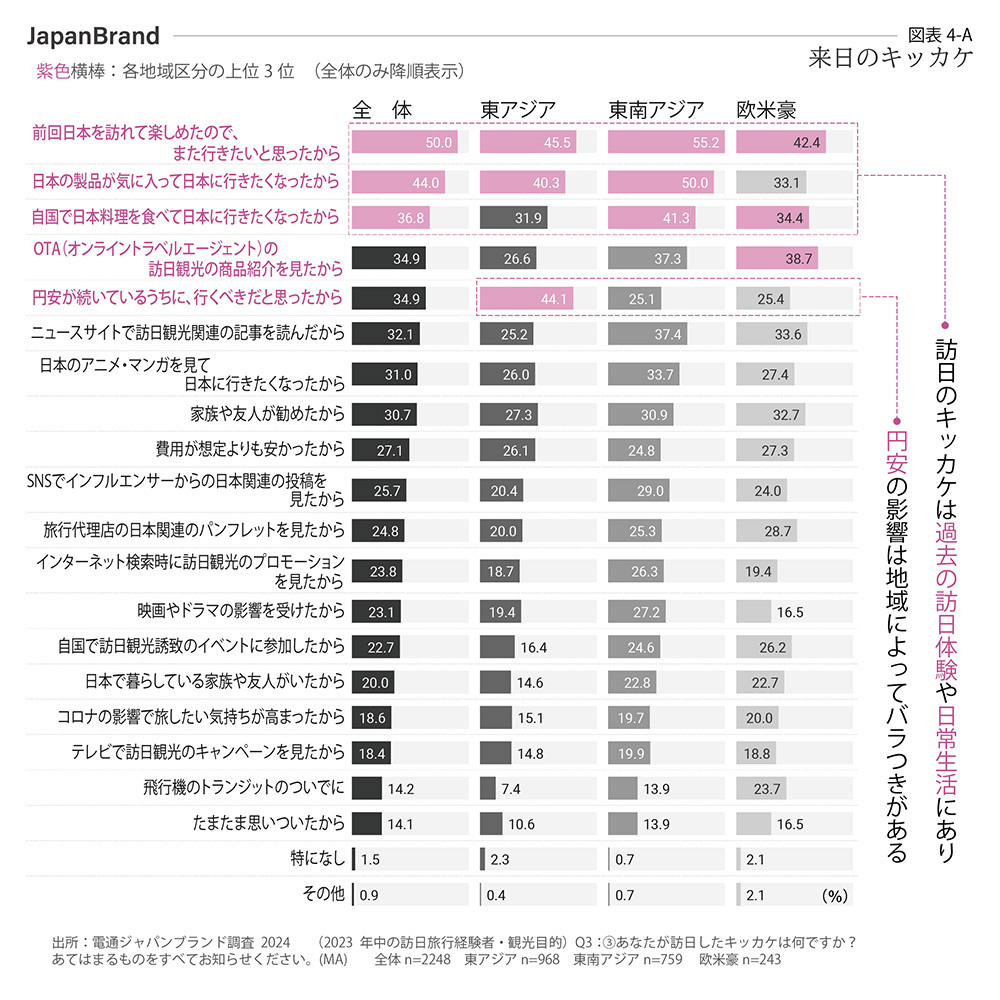
Point 03: Interest
One of the most important items in this survey is "experiences in Japan that interest them."
By regularly observing what people want to do, see, and buy in Japan, we can identify various trends—what changes and what remains constant, what aligns with perceived values and what feels incongruous—and gain valuable insights.
First, regarding the Nature & Culture category: Experiencing the four seasons, nature tourism, Japanese gardens, and visiting World Heritage sites are consistently high-interest items.
Southeast Asia showed the highest interest in farm stays. In contrast, Europe, America, and Australia had higher selection rates for park-related activities, contrasting with East Asia. Interest in farm stays was exceptionally high in Southeast Asia, showing a gap of more than double compared to East Asia and Europe, America, and Australia.
Furthermore, regarding classic activities for visiting Japan like theme parks, hot spring experiences, and traditional cultural experiences such as kimono, tea ceremony, and festivals, a significant difference was observed between East Asia and Europe/America/Australia. [Figure 5-A]
Next, regarding the shopping, dining, lodging, and transportation categories: Japanese-brand food products and Japanese cuisine-related items consistently rank high in interest. Japanese cuisine occupies top positions in experience intentions across all regions, its popularity undeniable. Furthermore, Asian markets continue to appear as a strong target for Japanese-brand cosmetics. Support for OTC medicines (medicines available without a prescription) from East Asian consumers is immediately apparent.
Regarding lodging, which accounts for a significant portion of spending, regional differences in interest toward hot spring inns are evident. For transportation, interest in using urban transit (trains, subways, buses) and the Shinkansen (bullet train) was high. [Figure 5-B]
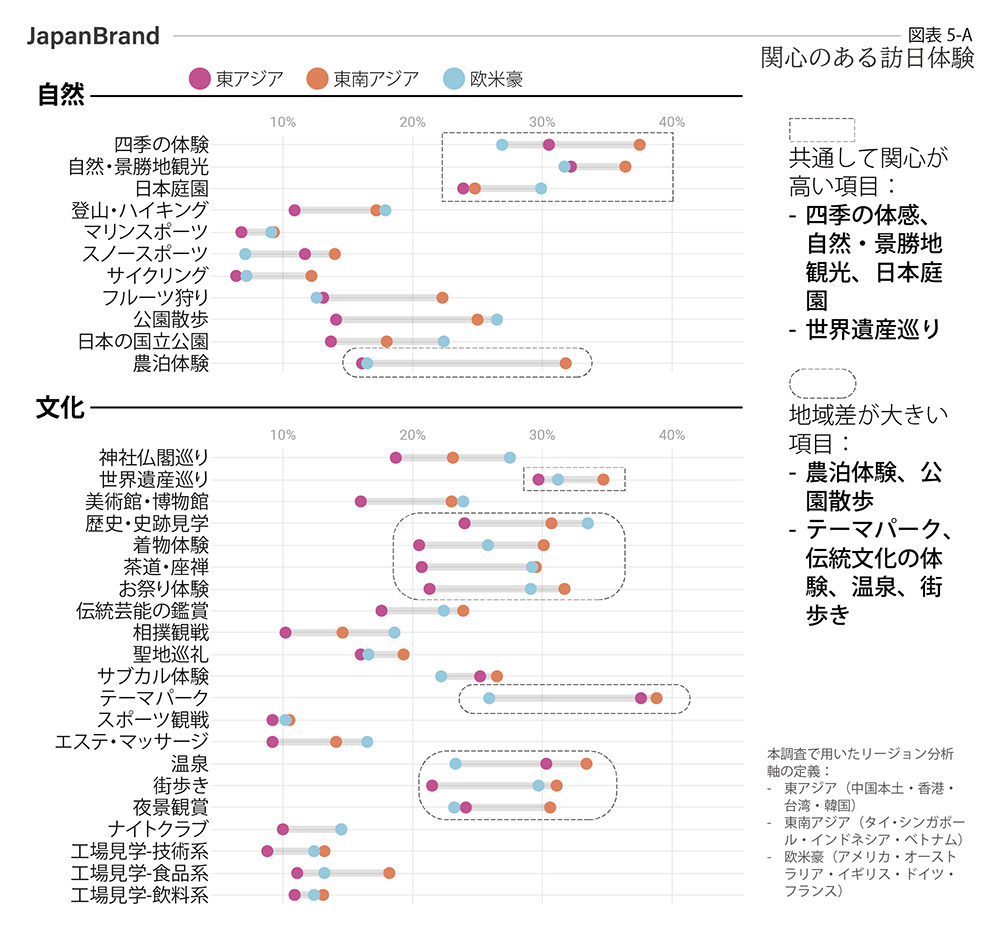

Having examined overall interest in visiting Japan, visualizing "what visitors are willing to pay for during their stay" is now a key challenge as the focus shifts toward increasing per-capita spending (boosting on-site consumption).
Therefore, this report visualizes nearly 30 essential paid tourism experiences in a country/region ranking format. Beyond staples like food and hot springs, we infer that "Japanese convenience store foods," "Japanese traditional crafts," "farm stays," and "Shinkansen travel" could also be high-value content contributing to increased spending.
Looking at specific countries and regions, izakaya (Japanese pubs) ranked highly in South Korea, Hong Kong, and Taiwan—markets with high repeat visit rates—indicating a tendency to seek deeper, more authentically Japanese experiences. [Figures 6-A, 6-B]
Point 04: Regional Areas
Directing visitors to regional areas is thought to not only revitalize local economies but also help curb overtourism in urban centers. Alongside refining each region's tourism resources, it is essential to regularly assess their current level of recognition. The Japan Brand Survey regularly gathers data on prefectural recognition, visit experience, and visit intent, which contributes to zero-level analysis, allowing us to closely monitor these trends.
The latest data shows that regardless of region, "Tokyo" significantly outpaces all others in all three indicators, demonstrating overwhelming presence. When viewed by region, it is clear that Asia and Europe/America/Australia are in distinctly different phases for each indicator. [Figure 7-A]

On the other hand, prefectures other than the relatively well-known Hiroshima, Nagasaki, Fukushima, Fukuoka, Okinawa, and Chiba share a fundamental challenge: insufficient awareness. This polarization is by no means a recent phenomenon. Looking back at past editions of this survey, a broadly similar trend was observed. The top five in awareness remained unchanged: Tokyo, Osaka, Kyoto, Hokkaido, and Hiroshima. [Chart 7-B]
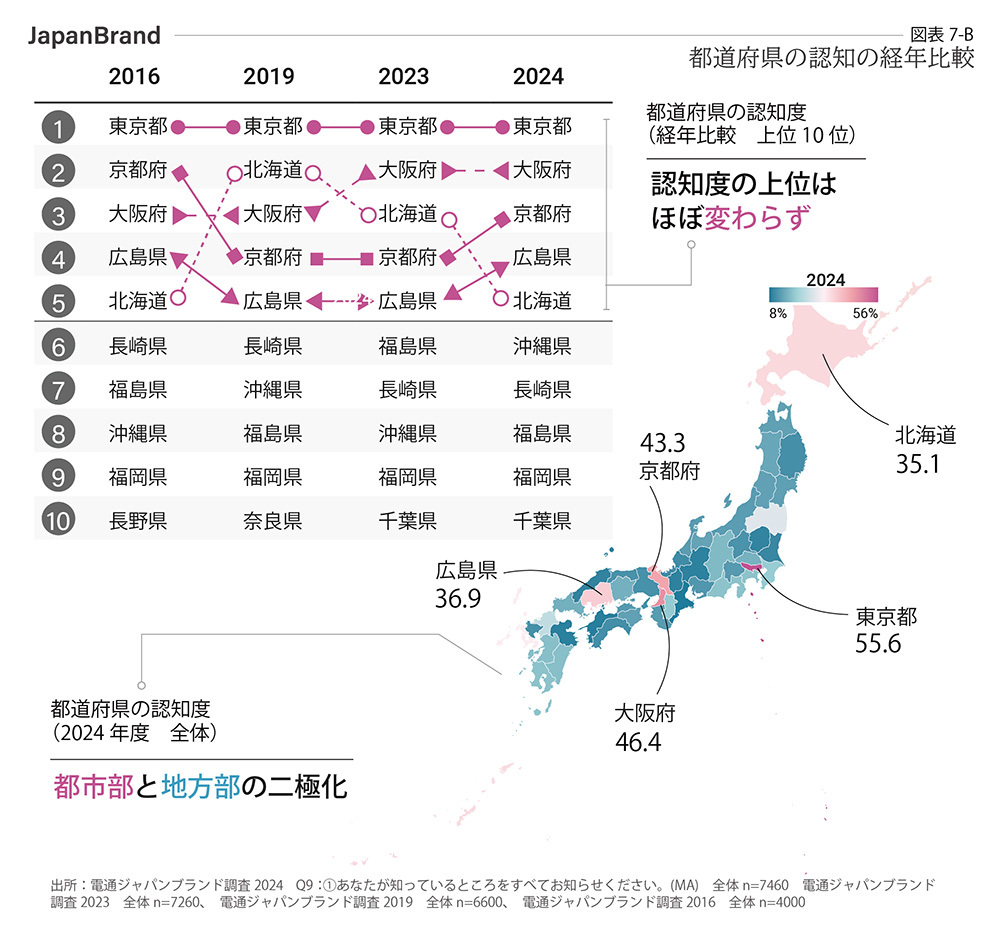
Furthermore, let's examine the situation by country. Comparing Korea, the largest source of visitors from Asia, with the United States, the largest source from Europe and America, we see that in Korea, awareness of the so-called "Golden Route" and the Kyushu region is high. In contrast, in the U.S., Tokyo is overwhelmingly dominant, far surpassing other destinations. Additionally, in both countries, visitation intent correlates with awareness; the majority of lesser-known prefectures also had low visitation intent. [Figure 7-C]

Being known doesn't necessarily guarantee a strong desire to visit, but if a place isn't known, it's unlikely to even be considered as an option. Each municipality has its own desired image and unique assets, and the target audience they aim to attract often varies significantly between local governments. When comparing the ideal (To be) with the current reality (As is), a gap inevitably exists. Where should we attract visitors from? Where should we focus our efforts? This gap between ideal and reality demands both cool-headed analysis and passionate decision-making.
Point 05: Obstacles
Another crucial factor to understand when attracting visitors to regional areas is the barriers to regional tourism. In this survey, we deliberately formulated hypotheses to investigate these barriers. The results clearly identified two major challenges for overseas residents: ① Language barriers and ② Lack of information.
The overwhelmingly dominant barrier is language, as evident from the heatmap below (darker colors indicate higher scores). This tendency is particularly pronounced among the potential segment with no prior visit to Japan.
The second major barrier is a lack of information across various layers. There is a fundamental lack of awareness about regional tourist destinations outside well-known cities, coupled with insufficient sources to learn about them. Furthermore, insufficient information about secondary transportation to reach these regions is also a challenge. We infer that the barrier posed by a fundamental lack of understanding of Japan's road conditions and traffic rules is higher than the barriers related to the means of transportation themselves, such as connecting transport (trains, buses, rental cars, etc.) or supplementary transport (ride-sharing, etc.). [Figure 8]
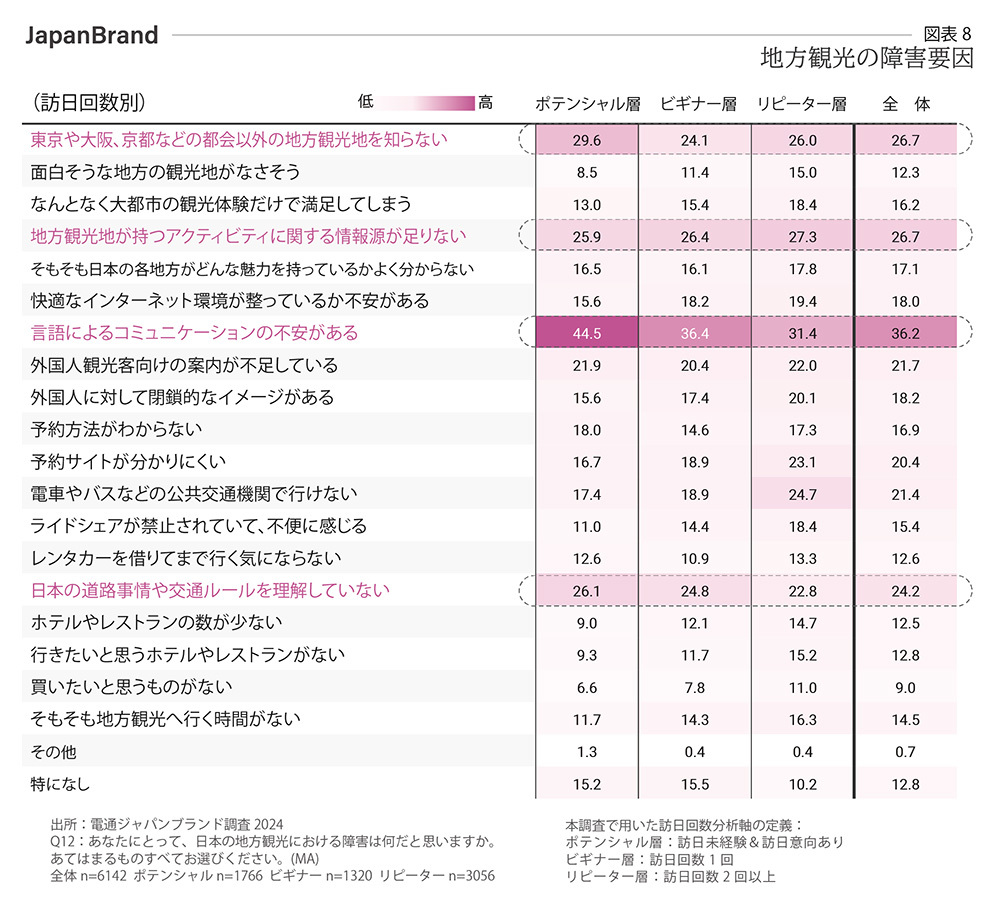
As a side note related to regional tourism, I'll briefly touch on the issue of overtourism, which has become problematic in recent years. This is not unique to Japan; nearly all famous tourist destinations worldwide are grappling with overtourism issues.
Currently, the pandemic-induced reset has prompted the implementation of various solutions, both large and small. Globally, there is a growing reevaluation of the tourist experience, the quality of life for local residents, and the burden on social infrastructure and the natural environment. Each tourist destination faces the difficult task of determining its top priorities. And what can be said universally is that no optimal solution has yet been found anywhere.
Point 06: Japanese Cuisine
Starting this fiscal year, we introduced the frequency of Japanese cuisine consumption by situation as a survey item to measure the penetration of Japanese food.
For eating out and takeout/delivery, the rate of consuming Japanese food at least once a month is around 70% in Asia and less than 60% in Europe, America, and Australia. For home cooking, it is less than 70% in Asia and less than 60% in Europe, America, and Australia.
In Asia, the consumption rate for eating out and takeout is about 10% higher than for home cooking, whereas in Europe, America, and Australia, this ratio shows little change. This may reflect the developed eating-out culture in Asia. [Chart 9]
*Regarding the definition of consumption situations
-
Prepared meals (purchasing pre-cooked foods, takeout such as bento boxes and side dishes, delivery, etc., consuming foods prepared outside the home at home or the workplace)
-
Home-cooked meals (meals prepared and eaten at home)

Next, we surveyed visitors to Japan about the dishes they ate during their stay and those they wanted to eat again after returning home. While there wasn't a huge difference in the specific dishes themselves, ramen consistently ranked top both during their stay in Japan and after returning home.
Furthermore, "Japanese-style curry" ranked within the top 20 most selected items for both during their stay and after returning home, indicating the significant overseas potential of curry, a national dish of Japan. [Figure 10]
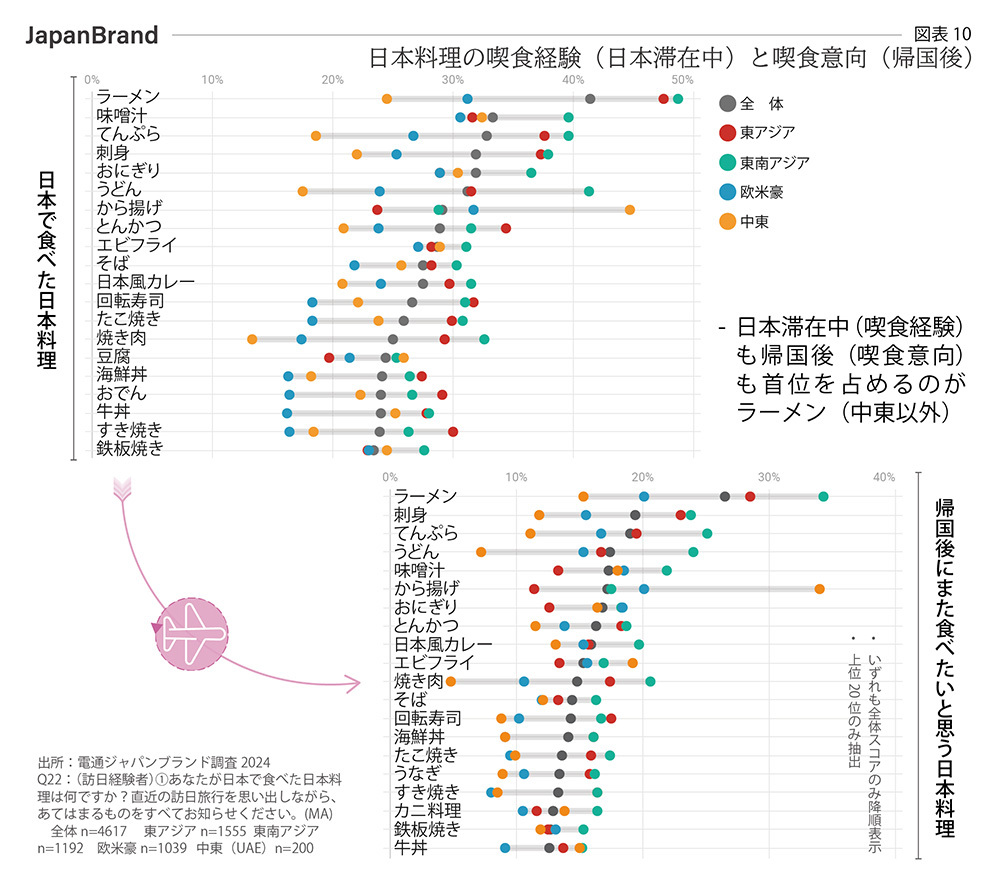
Food is a category with significant regional differences, and examining it by region revealed several findings. For example, items like karaage (fried chicken), yakiniku (grilled meat), ramen, tempura, udon, and sashimi showed substantial variation between regions. Karaage ranked first in the Middle East and Europe/North America/Australia, but it was not particularly popular in East Asia, ranking 25th. [Figure 11]

Furthermore, the food trends observed among the top items in each region offer valuable insights. Items showing high interest across both Asia and Europe/North America/Australia include ramen, sashimi, tempura, tonkatsu, and udon.
In East Asia, where Japanese restaurants are more prevalent than in other regions (※) and Japanese cuisine is relatively accessible, the range of dishes people want to eat again after returning home is broad.
In contrast, the Middle East shows significantly different trends. As the Middle East gains attention as a high-value-added traveler segment, understanding its food preferences will become increasingly important for restaurants in tourist destinations. [Chart 12]
※Based on calculations using data from the Ministry of Agriculture, Forestry and Fisheries, Export Planning Division, Export and International Affairs Bureau, "Survey Results on the Number of Japanese Restaurants Overseas (2023)," East Asia accounts for approximately 57% of the total number of Japanese restaurants worldwide. [Chart X]
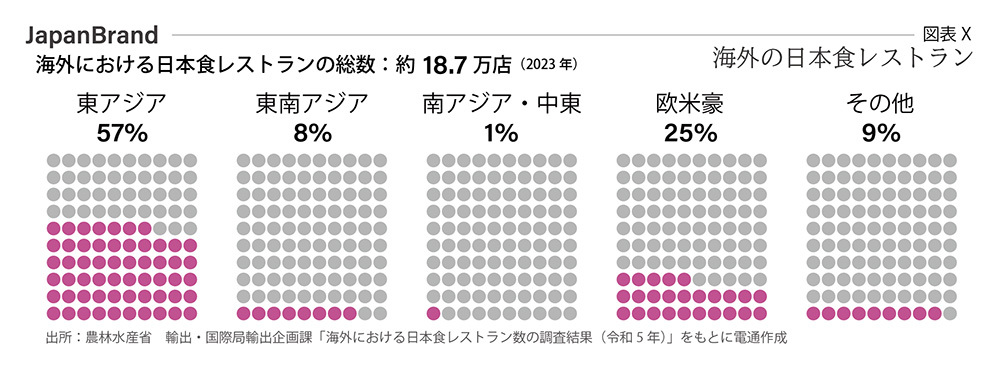
Point 07: Appeal
Last year's Japan Brand Survey 2023 explored Japan's overall appeal across four intentions: residence, employment, study, and travel. It revealed a difference in perception levels, with Japan viewed as "Excellent" from an Asian perspective and "Good" from a Western perspective.
This year's Japan Brand Survey introduced a new approach, attempting relative comparisons with four countries (Singapore, South Korea, the United States, and the United Kingdom).
In evaluations from East Asia, the UK, US, and Singapore were closely matched across all five dimensions (intent to live, work, study, travel, and partner for business), with Singapore holding an advantage over Japan. Evaluations from Southeast Asia showed close competition among all countries except South Korea. When viewed as a place to live or as a business partner, Japan is at roughly the same level as Singapore.
The differences between Europe, America, and Australia and Asia are clear. Intentions toward the US and UK show little variation, reflecting characteristics typical of a shared cultural sphere. Japan occupies an intermediate position across all indicators, showing a slight advantage over Singapore and South Korea. [Figure 13]
Point 08: Employment
As competition between nations intensifies, including the battle for talent, chronic labor shortages are becoming increasingly apparent across various industries. This is an area where, in addition to promoting women's participation and re-employment of older workers, the utilization of foreign talent is also expected. Currently, various policies for foreigners are in place, such as the Special Highly Skilled Foreign Professionals Program (J-Skip) and the Training and Employment Program. This survey analyzed not only the intention to work in Japan but also the reasons behind it.
[Those Unwilling to Work in Japan]
The primary reasons cited for not wanting to work in Japan are "Satisfaction with working in their home country" and "Significant concerns about communication due to lack of Japanese language skills." The scores for these two reasons significantly outrank those for the third-ranked reason and below.
Next, when viewed by region, dissatisfaction with working in their home country is not apparent in Europe, America, and Australia, while concerns about Japanese language ability are prominent in Asia. Furthermore, East Asia has the lowest expectations for Japan's economy. [Figure 14-A]

[Those Interested in Working in Japan]
Overall, the top reasons cited are "improved quality of life," "safety and security," "salary," "expectations for Japan's future economy and market," and "attractiveness and potential of Japanese companies."
By region, "improved quality of life" is the most common reason across all groups. This likely reflects widespread recognition of Japan's high standard of living.
Among the three regions, Southeast Asia shows the highest satisfaction with "salaries" and "safety," while East Asia cites "convenience and livability" and "attractiveness and potential of Japanese companies" as key drivers for employment intent. In Europe, America, and Australia, "expectations for Japan" and "confidence in cross-cultural understanding" rank highly. Additionally, significant regional variations are observed in factors like salary and talent development systems. [Chart 14-B]

Reflecting on these results, Western countries—which consistently rank highly in various indices reflecting national strength and appeal—are also nations known for their high quality of life. Attracting talent from such countries is inherently challenging, and adding language barriers significantly shrinks the available talent pool.
Regarding Asia, while Japan's popularity in Southeast Asia is undeniable, when compared to countries that offer a similarly high quality of life and where English is widely spoken, Japan faces a stark challenge in clearly demonstrating its competitive advantage. As already evident from the employment preferences mentioned earlier, not only the US and UK but also Singapore emerge as formidable competitors.
As environmental changes inevitably progress, we must engage in the fundamental discussion of what needs to be prepared to attract talent that will strengthen national power, while maintaining Japan's unique identity and Japanese-style dedication.
Conclusion
Finally, I would like to conclude this report with two keywords.
The first is the "Matthew Effect," proposed by American sociologist Robert King Merton approximately 55 years ago.
Whether it's nations or organizations, cities or rural areas, tourism or employment, resources increasingly concentrate in places that are well-known or outstanding. These accumulated resources then enable further evolution to greater heights. Conversely, the opposite path leads to a steady decline, with the risk that even the resources originally possessed may deteriorate.
This phrase confronts us with various realities and seems to be a remarkably accurate and universal observation.
The second is "Idols." Idols are Latin words meaning idols or illusions. It is said that humans primarily have four types of biases. According to Francis Bacon, the greatest intellectual of 16th-century England, in his "Four Idols,"
① The Idols of the Tribe (Illusions)
② The idols of the cave (preconceptions stemming from environment or personal experience)
③ Idols of the Marketplace (gossip and conspiracy theories in workplaces or online)
④ The Idols of the Theatre (blind faith in authority)
These represent the primary assumptions and prejudices that plague our social lives.
Not only in cross-cultural understanding, but even within highly homogeneous societies, we cannot escape the Idols theory outlined above. The same holds true for all market research and data analysis.
In various aspects of work and life, we must acknowledge the existence of biases that cannot be completely eliminated. With this understanding, I urge you to consider what defines "Japanese-ness," what constitutes sustainable prosperity, and what is truly necessary when engaging with global and cross-cultural contexts.
※1: Country and region names used in this article are based on Japanese social norms and business practices, assuming a Japanese domestic readership.
※2: The composition ratios in this survey are rounded to the second decimal place (or the first decimal place for some integer values), so the total may not add up to 100%.
※3: The maps used in this survey (world map and Japan map) have been partially modified, processed, or cropped to suit the analysis content and page layout. They do not necessarily accurately reflect national borders or territorial boundaries.
※4: When creating figures and tables, country/region names use ISO 3166-1 alpha-3 codes due to space or layout constraints.
【Contact for Inquiries Regarding This Matter】
Dentsu Japan Brand Survey Project Team
japanbrand@dentsu.co.jp
【About the Dentsu Japan Brand Survey】
Dentsu's proprietary survey initiated in 2011 to understand how the Japan brand was perceived globally when reputational damage occurred to Japanese agricultural and marine products and inbound travel following the Great East Japan Earthquake. In 2022, the survey design and output underwent significant renewal, evolving into a company-wide cross-functional project activity.
It regularly gauges the perceptions and actual behaviors of overseas residents regarding the Japan Brand as a whole, covering areas such as inbound tourism, food, Japanese products, content, and values. By visualizing the changing sentiments of consumers and the challenges facing the Japan Brand, it contributes to increasingly complex corporate activities and promotes cross-cultural understanding within Japanese society.
【Dentsu Japan Brand Survey 2024 Overview】
・Target Areas: 15 countries/regions (United States, Australia, United Kingdom, Germany, France, India, United Arab Emirates, Indonesia, Singapore, Thailand, Vietnam, Mainland China, Hong Kong, Taiwan, South Korea)
・Respondent Criteria: Men and women aged 20–59 (middle-income and above)
・Sample Size: 7,460 (Breakdown: USA 960, India 900, Mainland China 800, Other countries/regions 400 each)
・Survey Method: Online survey
・Survey Period: January 19 to March 26, 2024
・Research Agency: Video Research Ltd.
*5: Mainland China survey areas limited to Shanghai and Beijing; India survey areas limited to Delhi, Mumbai, and Bengaluru.
※6: Definition of Middle Income: Conditions set for each country based on national average income (using OECD statistics, etc.) and social class classification (SEC).
※7: Samples were collected with equal allocation by gender and age group for each country/region, then weighted to match the population composition.
Was this article helpful?
Newsletter registration is here
We select and publish important news every day
For inquiries about this article
Author

Li Shunshi
Dentsu Inc.
First Business Transformation Bureau
Planner, Producer
Guided by the mottos "Everything flows" and "A blessing in disguise," I engage in diverse projects while transcending specializations in marketing, research, media, global operations, and project management.


